Articles and Features
Skagen Painters: The Art of Capturing Light
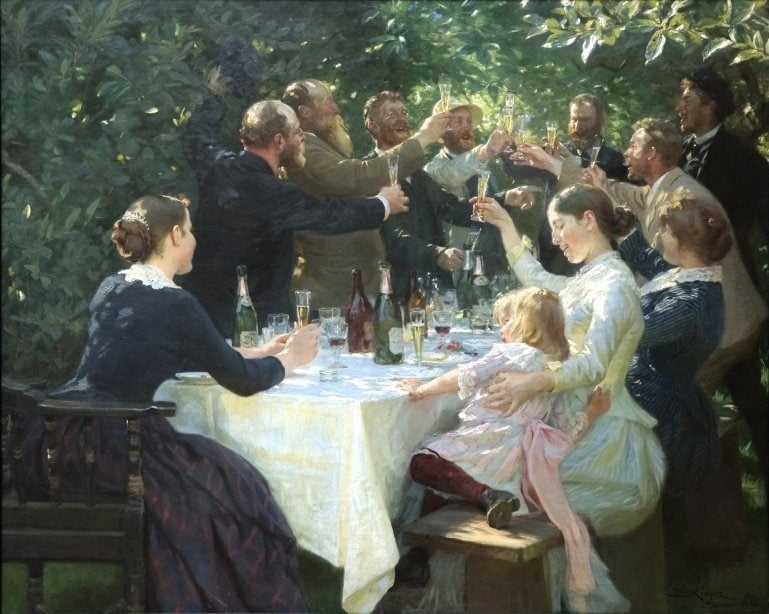
By Sara Marín
The idea of capturing the essence of light and its fleeting qualities has fascinated artists (not only painters!) for centuries. And while the Impressionists certainly come to mind when we think of the artists’ ability to capture and transfer light onto canvas, the French art movement was strongly influenced by prior experiences and innovative practices.
In the late 18th century, in fact, with Romanticism, light started being intrinsically connected to landscape painting just as this was starting to affirm as a new genre with an independent subject matter. Masters of light of the period were British William Turner and John Constable, who used to take notes outdoors to then continue working in their atelier. While the use of light in French Realism lent tactility and intensity to everyday working-class scenes, the Barbizon School embraced en plein air painting and focused on the effects of light on nature, especially the terrain of the Fontainebleau Forest. These experiences would have a great impact on Impressionism and its characteristic depictions of city life in Paris as well as the French countryside.
A lesser-known but equally fascinating chapter in the longstanding challenge of capturing the ephemeral atmosphere of ever-changing environments involved a Scandinavian art colony in a small town in the northernmost point of Denmark. Here, a group of artists found in the small town of Skagen an endless source of inspiration, making the charming Danish port town part of an international phenomenon and a nexus for free artistic expression.
The Skagen Colony of Painters
Skagen, in northernmost Jutland, was a popular fishing village and summer destination for middle-class city people who looked for a getaway place to relax. It was during the last quarter of the 19th century that the group of Scandinavian artists who would come to be known as the Skagen painters made the seaside town the perfect site to periodically gather and paint its people and landscapes. They found that remote town particularly charming from the very first moment they set foot on it – some of them even settled in Skagen permanently, mesmerized by the variety of subjects they could depict.
The origins of this artists’ colony trace back to the early 1870s when some young artists attending the Royal Danish Academy of Fine Arts in Copenhagen and the Royal Swedish Academy of Arts, dissatisfied with the traditional education given by both art institutions, looked for new, less conventional approaches, closer to the groundbreaking art movements happening in Europe.
Karl Madsen (1855-1938, Copenhagen) was the first member of the group who visited Skagen, along with fellow artist Michael Ancher (1849, Bornholm-1927, Skagen) in 1874. Skagen offered the opportunity to practice en plein air painting, allowing the artists to catch the light from nature right away, making every scene different from the other based on the season and moment of the day.
Around the mid-1870s, many Scandinavian artists started to frequent the town, sojourning at the Brøndums Hotel, the only guest house in the village that quickly became their favourite place to gather, mingle, and discuss art. Some notable members of the Skagen painters were: Anna Ancher (1859-1935), Holger Drachmann (1846-1908), Viggo Johansen (1851-1935), Marie Krøyer (1867-1940), Peder Severin Krøyer (1851-1909), Laurits Tuxen (1853-1927), among others.
Throughout the 1890s, the arrival of crowds of tourists due to the newly-built railway along with the death of its core members in the following years started to mark the end of the artists’ colony, although the artists who had moved to the village, such as the Anchers and Krøyers, continued painting until the 1920s. In 1908, however, anticipating the importance of the Skagen School, artists Michael Ancher, P.S. Krøyer and Tuxen, with the Brøndums Hotel proprietor Degn, and the pharmacist Victor Chr. Klæbel converted the dining room of the Brøndums Hotel, building the foundations of the Skagens Museum, which was inaugurated in 1928. Over time, the Museum has been relocated, modified and enlarged, and added the houses and studios of the Anchers and Drachmann.
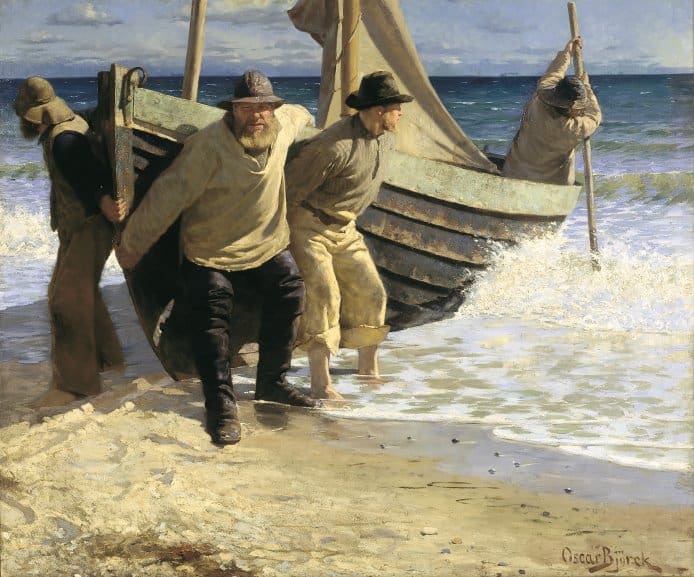
Subjects, style and technique
The Skagen painters depicted their natural surroundings, typically beaches, dunes, and fields, as much as the people who inhabited the land. Living among the largest fishing community in Denmark, they were fascinated by the dangers the local fishers had to face in their everyday life sailing the rough Baltic Sea under stormy skies and made sure to express this bravery in their paintings. But sailors were not the only figures Skagen painters liked to depict, from peasants working in the fields (reminiscent of the work of Jean-François Millet) to their fellow artists. There are numerous representations in which Skagen members are celebrating, playing cards, walking along the beach, allowing a peek into the life of bourgeois artists trying to experience a bohemian lifestyle far from the growingly industrialized big cities.
The group didn’t have rigid rules in terms of style but was united by the shared passion for painting outdoors. This approach allowed them to capture the ephemeral nature of light and color on their subjects and render it on the canvas, often resulting in short and hasty brushstrokes.
About some members
Any artist was welcome at the group meetings in the Brøndums Hotel, and the colony often received visits from relevant cultural personalities from Scandinavian countries. Also a bit romantic are the stories between Anna and Michael Ancher and Marie and P.S. Krøyer, whose marriages consolidated even more the relationships between the young artists from the city and the Skagen women (Anna and Michael Ancher’s case).
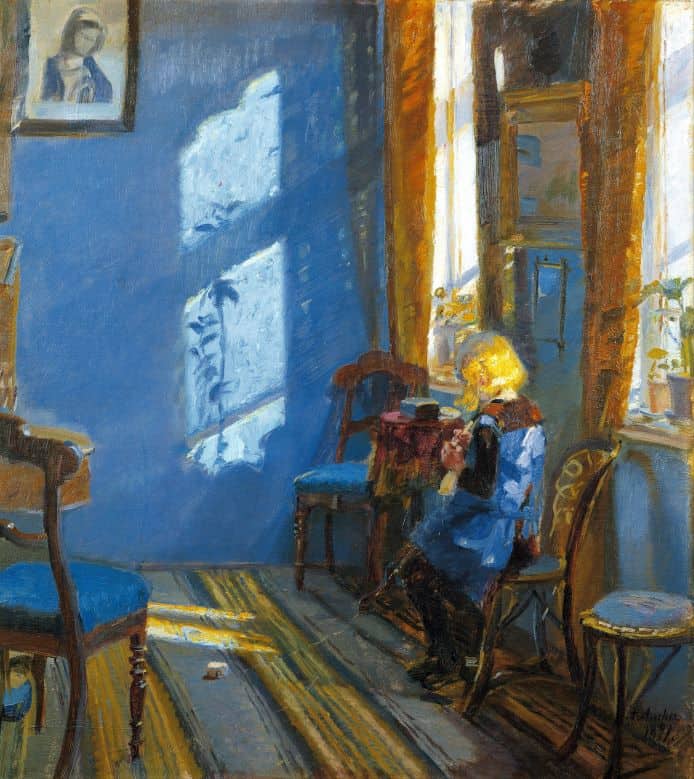
Anna Ancher
Anna Ancher (née Brøndums) was the only core member of the group who was born, raised and died in Skagen. She started developing an interest in painting when she met her future husband, Michael Ancher, who frequented the Brøndums guest house of her family and whom she married in 1880, settling permanently in Skagen. An exceptional case for a woman artist at the time, she devoted herself to painting all her life as her profession. She shared a studio with her beloved husband, portrayed each other, and specialized in depicting interiors and the religious life in Skagen. Her favorite models were women and children, mostly her family and friends.
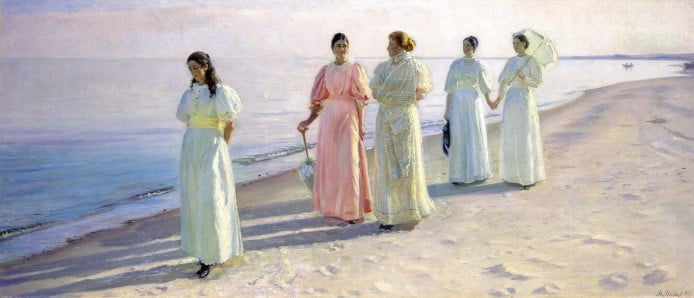
Michael Ancher
Unhappy with the conservative artistic training received at the Danish Academy, Michael Ancher headed to Skagen and fell in love with more than just the town. His dearest scenes always involved a beach setting, be it fishermen who had struggled to return to the seashore or well-dressed women walking by the sea. He was one of the founders of the Skagens Museum.

Marie Krøyer
A talented artist and an advocate for women’s rights to get an artistic education, Marie Krøyer (née Triepcke) helped establish the Little Painting School (Den lille Malerskole), as women were not allowed in the academy. She studied privately from the 1880s, as she had always wanted to become a painter, though her marriage with P.S. Krøyer, the unofficial leader of the Skagen painters, complicated her artistic possibilities as a woman, adding to her lack of confidence. Living in the shadow of her husband’s artistic career, in the 1890s Marie gave up on painting and dedicated herself to interior and furniture design, inspired by the English Arts & Crafts movement
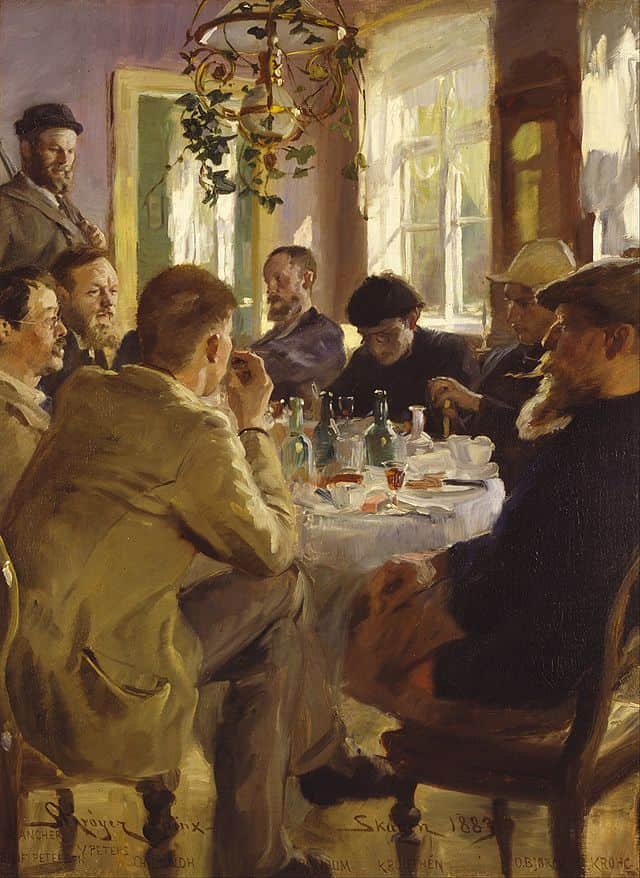
P.S. Krøyer
The most successful among the Skagen painters P.S. Krøyer rapidly embraced the Impressionist approach and technique, unsatisfied with the Danish Academy. He was already a well-recognized artist when he set foot in Skagen for the first time in 1882. He married Marie and moved to Skagen, but they had a turbulent relationship, troubled by his mental illness, which eventually led to their divorce.
Relevant sources to learn more
Read more articles from Artland Magazine
Art Colonies – Where Artists and Movements Were Shaped – with a section dedicated to the Skagen painters
Artist Colonies Of Our Times: Collective Forms of Creating and Living
Other relevant sources
Take a look at the official site of the Art Museums of Skagen
Read about the exhibition dedicated to Anna Ancher in 2013 organized by the NMWA
Wondering where to start?



